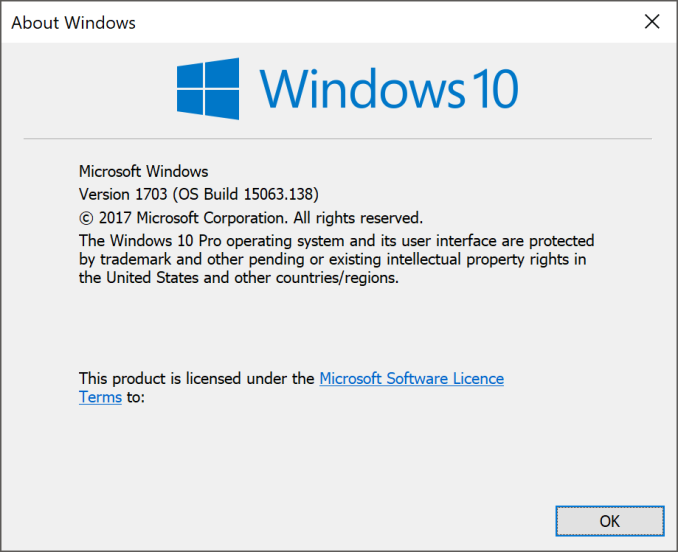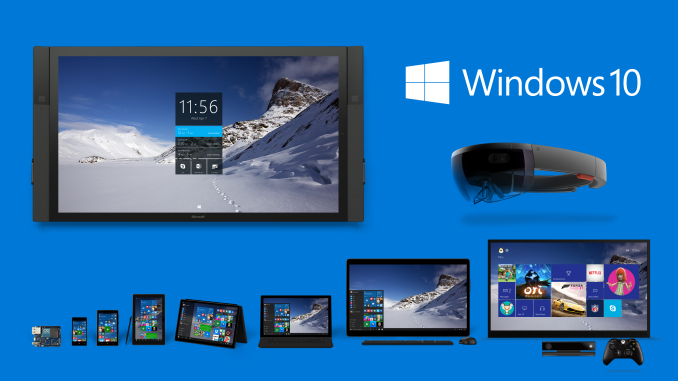The Windows 10 Creators Update Arrives
by Brett Howse on April 25, 2017 8:00 AM EST- Posted in
- Software
- Operating Systems
- Windows
- Microsoft
- Windows 10

Windows 10 launched in July 2015, and on April 11, 2017, Microsoft released the third major update to their latest operating system. First announced in October with the Surface Studio, Microsoft has dubbed the latest update the Creators Update. Officially it is Windows 10 version 1703, OS build 15063. Naming it the Creators Update seems to signal some future intentions, but the actual release is less creative than the hardware they announced with it, and feels a bit like the company really just didn’t want to call it Windows 10 SP1 R2. Compared to the last major update, named the Anniversary Update, this version has less big features, but does bring a few new things to the OS along with some more polish.
With the new “Windows as a Service” model that came with Windows 10 in July 2015, more small updates seem like the proper method for servicing Windows, but Microsoft is definitely pulled between the consumer and business groups that they serve. Consumers want more features, and sooner, but business needs to test everything before rolling it out. They must walk this tightrope between the two groups, and it’s not clear that they have struck the right balance yet. With this update coming early in 2017, and an announcement of another event in New York City in early May, it does seem like there will be a second update later this year too.
Throughout it all, they have kept their successful Windows Insider program running, and they are now citing over 10 million people in the Insider Program. This feedback driven change has been very successful, even if certain features which have been highly requested still haven’t seen their introduction yet. The number of builds being released has ramped up significantly from when the program first started, and now it is not uncommon to see several builds released in a week. The overall quality of some of those builds has degraded though, so people running in the Fast Ring carry much more risk than before, but there are less risky rings to be in as well. Microsoft has also opened up the Insider Program to business as well, since they are going to need to stay on top of the changes.
Windows 10 is going to keep evolving for the foreseeable future, with regular updates being first tested with the Insider Preview program, and then rolled out to the general public. With almost two years of Windows 10 behind us, we can take a look at what’s improved, what needs work, and where Microsoft can go from here.












69 Comments
View All Comments
Ubercake - Tuesday, April 25, 2017 - link
When it comes to hardware of any kind coming out of Microsoft, count on Microsoft to stop producing and supporting (or in other words "giving up") on it within a couple of years. This Surface Studio is a fantastic idea. The Microsoft Band was a great idea/product. Now no longer supported/produced. The Surface RT was a great idea that wasn't supported after its 3rd year. Mainstream phone apps are still not there. Zune music player (sort of competing with iPod) was gone soon after it was started.The universal windows platform or whatever it won't be called because the hardware just won't be their to support the idea in a few years. Nothing portable device outside of the Surface Pro (all 10 of you Surface Pro users know what I'm talking about!) will be around using the Windows OS in a few years. Why is Microsoft focusing at all on a universal platform that isn't Android- or iOS-based when you know no Microsoft hardware is supported for more than a couple of years? So they can quit it in a couple of years like everything else?
xthetenth - Tuesday, April 25, 2017 - link
The reason the Surface 3 is gone without a successor is because the niche for a lower cost 2 in 1 is an ecosystem now, not a single product.Flunk - Tuesday, April 25, 2017 - link
Intel also pulled the plug on the line of Atom chips the Surface 3 used, leaving Microsoft high and dry. It's possible they'll come up with a new non-pro Surface that uses ARM chips, but that didn't sell all the great the first time.gerz1219 - Tuesday, April 25, 2017 - link
They seem to have a foothold with the Surface Pro, so I wouldn't expect them to kill that any time soon. The problem with Microsoft's hardware ventures is that many of them simply haven't sold very well. They kind of had to give up on the Zune when they had warehouses full of unsold units and it was clear that nobody wanted an alternative to the iPod. Same for Surface RT and the Windows phones.I think any Microsoft device that kind of overlaps with traditional desktops will be well supported in the future. It's their attempts to branch out into mobile that have routinely failed and been abandoned.
Holliday75 - Tuesday, April 25, 2017 - link
I have a Surface Pro. Who are the other 9 users? We should start a club!SaolDan - Tuesday, April 25, 2017 - link
SP4 FTW.Instyle - Thursday, April 27, 2017 - link
The Surface Studio is currently available so I have no idea what you're talking about there. The Surface Pro and Xbox lines have sold in the millions, have plenty of active users and are currently supported. The Zune was supported for quite a long time as well. I think you need to go do some research. The main failed products were Windows Mobile, Surface RT and Microsoft Band.DanNeely - Tuesday, April 25, 2017 - link
"Hopefully we’ll have a chance to dig into this a bit more in the future."Some things in game mode I'd be interested in seeing tested (and might try myself in a few weeks or month when I install the update) are if it helps distributed computing play any nicer with not just games but foreground apps in general. I run several BOINC projects with my spare CPU/GPU cycles. For the most part it just works on the desktop and with simpler games. Games that are GPU heavy or use multiple heavy threads are a problem though because the OS doesn't give enough GPU to keep frame rates up and effectively only lets the game have a single CPU core. Boinc's mitigation options are rather limited; basically I can set it so that when certain apps are running (by executable path) Boinc entirely stops CPU and/or GPU apps. It's all or nothing though (meaning I can't let it leave 4 cores free for my game and continue to do science on the other 4).
More recently I've ran into occasional problems with HTML5 video playback while a GPU apps are running. Years ago I had similar problems with the general desktop and some GPU apps, but that was a much more consistent case. This is far more intermittent and I haven't been able to nail down any sort of pattern yet. May try gaming my browser to see what happens.
dgingeri - Tuesday, April 25, 2017 - link
Why am I so much less enthused about this update than I was about the last big one? It just doesn't seem to have anything I'm interested in.kwall8 - Tuesday, April 25, 2017 - link
The best addition is an address bar in regedit. Only took them 20 years :D